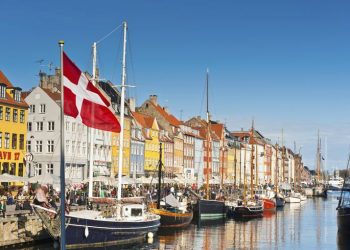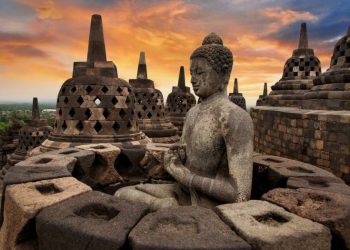Bandung, Indonesia Sentinel — Ngaben is a traditional Hindu cremation ceremony performed in Bali, Indonesia. This sacred ritual is essential for sending the deceased to the afterlife and helping their soul transition peacefully. The ceremony symbolizes the purification of the spirit and facilitates the return of the physical body to nature, while the soul is guided to the spiritual realm.
The History of Ngaben Ceremony
Ngaben is part of the Pitra Yadnya ceremonies, with Pitra referring to ancestors or the departed, and Yadnya meaning a sincere and holy offering. Together, Pitra Yadnya represents offerings made to ancestors. According to Hindu belief, a person is composed of three main components: the physical body (badan kasar), the soul (atma), and karma.
The physical body is formed from the five elements, known as Panca Maha Bhuta: earth (pertiwi), water (apah), fire (teja), air (bayu), and ether (akasa). These elements create the physical body, while the soul provides life. When someone dies, it is believed that only the physical body perishes, while the soul continues its journey. Death is seen as a transition of the soul from the physical world to the spiritual realm. Ngaben is performed to purify and release the soul from the body, allowing it to move peacefully to the afterlife and await reincarnation.
The ceremony aims to return the physical elements to nature and release the soul from its worldly ties, enabling it to safely reach the Pitra realm and prepare for its next life.
The Ritual Process of Ngaben
Ngaben Ceremony process in Bali rich with symbolism and spiritual significance, consists of a series of steps aimed at purifying and liberating the soul from the physical body. Below is an overview of the key stages of the Ngaben ceremony.
- Ngulapin: Seeking Divine Permission
The ritual begins with Ngulapin, a request for permission and blessings from Dewi Surga, the consort of Lord Shiva. This act is typically performed at the Pura Dalem (temple of the dead) or a location according to local customs, seeking divine approval to proceed with the cremation.
- Meseh Lawang: Symbolic Healing of the Body
Next is Meseh Lawang, a symbolic ritual aimed at healing any perceived damage or imperfections in the body. This is performed at the cemetery or a designated place and represents the community’s wish to ensure the body is whole and pure before it transitions to the next realm.
- Mesiram or Mabersih: Cleansing the Body
Mesiram, the cleansing or purification of the body, is a critical part of the ceremony. The body is washed and adorned with sacred items, such as jasmine flowers placed in the nostrils, small pieces of glass over the eyes, and leaves on the eyebrows. This ritual not only cleanses the body but symbolically returns the elements of the physical form to nature, preparing the soul for reincarnation with the hope it will be blessed with a complete and unblemished body in its next life.
- Ngajum Kajang: Releasing the Soul
The Ngajum Kajang ritual involves the use of a white cloth inscribed with magical symbols by a priest or cultural elder. Family members press this cloth three times, representing their emotional readiness to release the soul of their loved one to the next world.
- Ngaskara and Nerpana: Initial Soul Purification
The Ngaskara ceremony is the first stage of soul purification. This is followed by Nerpana, where offerings are made to honor the soul, helping to cleanse it and prepare it for its journey to the afterlife.
- Papegatan: Cutting Worldly Bonds
Papegatan is a ritual to sever the worldly attachments that bind the soul to this life. This ensures that the soul’s journey to the divine is not hindered by lingering emotional ties. The ritual involves offerings placed on a stone mortar, with two branches of the dadap tree positioned as a symbolic gateway. A white thread is stretched between the branches, which family members and pallbearers pass through, symbolically cutting the ties that connect the soul to the physical world.
- Pakiriman Ngutang: The Journey to the Cremation Ground
During Pakiriman Ngutang, the body is placed on a ceremonial tower known as a Bade or on a simple bier called Pepaga. Accompanied by the sound of a Baleganjur orchestra—a traditional Balinese gong ensemble—the body is carried in a lively procession to the cremation site. The body is spun three times counterclockwise along the way, representing the return of the body’s physical elements (earth, air, fire, water, and ether) to the universe. This spinning also symbolizes a farewell to the family, the community, and the physical world.
- Ngeseng: The Cremation
Ngeseng is the actual cremation of the body, which is placed inside a sacred replica of a bull, known as a Petulangan. The bull represents strength and serves as the vessel that helps the soul transition into the afterlife based on its deeds during life. Before the cremation begins, the officiating priest sprinkles the body with Tirta Pangentas—holy water symbolizing the cleansing fire—and recites sacred mantras. The body is then set alight, and after the fire consumes it, the remaining bones are collected, ground, and placed inside a hollowed-out coconut. This process is called Nuduk Galih, signifying the gathering of the final remnants of the physical body.
- Nganyut: Returning to Nature
The final stage, Nganyut, involves scattering the ashes at sea or in a river. This act symbolizes the return of the body’s water element to the earth and the soul’s reunion with the cosmic forces of nature, allowing it to continue its spiritual journey.
Did The Chilling Mystery of the S.S. Ourang Medan Solved?
Through the Ngaben ceremony, the Balinese not only honor their deceased but also reaffirm their connection to the spiritual and natural worlds, believing that death is merely a transition to the next stage of existence.
Ngaben in Bali tradition is more than just a funeral ceremony, it is a profound spiritual journey for the deceased and their family, representing the cycle of life, death, and rebirth that lies at the heart of Balinese Hindu belief.
(Raidi/Agung)

























